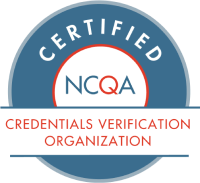Founded in 1990 with the mission to systematically improve healthcare quality, NCQA is considered the gold standard when it comes to credentialing requirements. We think it’s important to understand and get the most out of the NCQA credentialing requirements. In this post, we’ll explore the six common mistakes we’ve seen healthcare organizations make as they endeavor to meet NCQA standards.
1. Not having credentialing policies outlined and in place
- The Standard: NCQA’s CR1 declares that all healthcare organizations should have a “a well-defined credentialing and recredentialing process for evaluating and selecting licensed independent practitioners to provide care to its members.”
- The Mistake: Organizations might have credentialing policies, but they aren’t fully documented or fully established. The policies need to address which practitioner types will be credentialed, what verification sources will be used, the credential criteria, the process for decisions, the process for delegated credentialing, and many more elements.
- The Solution: The first step in avoiding this mistake is to understand the NCQA credentialing requirements. Second, work with your credentialing team to document clearly and concisely your organization’s credentialing process step by step.
2. Inefficient credentialing committees
- The Standard: Similar to CR1, CR2 is interested in documenting and standardizing the process for the credentialing committee: “The organization designates a Credentialing Committee that uses a peer-review process to make recommendations regarding credentialing decisions.”
- The Mistake: Credentialing committees are imperative to a high-quality credentialing process, but without a clearly documented process in place, these committees can become overly expensive. Inefficient committees aren’t able to process the number of files they need to meet your organization’s need for credentialed healthcare professionals. Delaying turnaround times because of an inefficient credentialing committee is not only costly but also delays all the subsequent steps in your workflow and can appear unfriendly toward providers who are new to the network.
- The Solution: Help your committees make good, well-informed choices by setting up clear policies and procedures for when providers fall outside the norm. We typically see customers establish thresholds of acceptance to expedite the review process. For example, establish an allowable limit on malpractice amounts. In addition, choose to use technology to enable remote meeting sessions (see CR 2 Factor 2). It’s also a good practice to establish a policy that enables the credentialing team to make decisions on most files and reserve the committee’s time for files that need extra care or validation. The credentialing team or CVO should also be able to investigate any file that goes to the committee–in advance of the review–so that committee can make an informed decision, rather than simply request more information and delay the decision-making process. If the committee does delay its decision, ensure that the provider is informed throughout the process.
3. Not checking for work history gaps and gap explanations
- The Standard: According to CR3, Element A, Factor 5, “If a gap in employment exceeds six months, the practitioner clarifies the gap verbally or in writing. The organization documents a verbal clarification in the practitioner’s credentialing file. If the gap in employment exceeds one year, the practitioner clarifies the gap in writing.”
- The Mistake: Work history can seem repetitive in a credentialing process, especially if the provider is a new hire. Reviewing a provider’s work history for credentialing requirements has less to do with where a provider has worked for the last five years and more with when. If a provider has a gap of six months or more in his/her work history, he/she must attest as to why the gap exists for the application to be deemed complete by NCQA credentialing requirements.
- The Solution: Reviewing a few CVs a month may be manageable for in-house operations, but if your organization processes any significant volume, it can become nearly impossible. A technology-enabled CVO can complete the tasks automatically and more quickly and accurately than a human with a spreadsheet.
4. Outdated attestations
- The Standard: Also found within CR3 is another commonly ignored or forgotten requirement: Element C Factor 6: “current and signed attestation confirming the correctness and completeness of the application.”
- The Mistake: Getting providers to re-attest can be more frustrating than using dial-up Internet. While allowing a newly outdated attestation to slip through may be the easier path, it makes the provider file incomplete for a reason.
- The Solution: To solve this problem, make the process easy for your providers. Providers don’t avoid attestations because they are stubborn but because they are busy! But it is possible to meet the needs of your providers and your credentialing team. andros offers a new provider application that takes 15 minutes to complete and includes attestation questions. If a provider can finish quickly and answer everything in one place, he/she is more likely to be compliant.
5. Failing to monitor your providers in between credential cycles
- The Standard: In CR6, NCQA credentialing requirements ask that “the organization develops and implements policies and procedures for ongoing monitoring of practitioner sanctions, complaints and quality issues between recredentialing cycles and takes appropriate action against practitioners when it identifies occurrences of poor quality.”
- The Mistake: It’s easy and convenient to finish credentialing providers and not think about them again for 36 months until the next credential event, but doing so in making your organization noncompliant–and potentially liable.
- The Solution: Several sources need to be continuously monitored for all of your providers, which is why this is one of the most commonly overlooked NCQA credentialing requirements and one of the most important. While you can dedicate team members to this job, it can easily become overwhelming and repetitive, and mistakes can be made. If you want to guarantee accuracy and automate your process, andros offers ongoing monitoring of expirables, sanctions and adverse actions for all of your providers. Our automated system will keep your organization up to date on all your providers, whether you have 10 or 10,000 providers to monitor.
6. Mishandling your delegated credential agreements
- The Standard: CR9 Delegation of CR Element A is the final mistake that we will cover today. The NCQA requires a written delegation agreement that outlines mutual agreement, assigns responsibilities and addresses reporting requirements, performance monitoring and consequences.
- The Mistake: The bottom line is that delegated credentialing is confusing; we have seen healthcare organizations so intimidated by the process that they give up, even though setting up a delegated relationship could significantly reduce costs.
- The Solution: A properly set up delegated relationship can save money for both provider organizations (hospitals, urgent care centers, home care companies, etc.) and for payers. Provider facilities take control of the credentialing, reducing the turnaround time and expediting the process, allowing providers to see patients more quickly. Because this is such a nuanced topic, we have an entire blogpost dedicated to understanding what a delegated relationship is and what it should look like. If you are ready to explore the cost-saving possibility and decrease the number of credentials you need to process, you can request a consultation with andros. Whether you just want help better understanding delegated credentials or you prefer that someone else just handle it for you, we’re happy to help.
Most payers we work with don’t experience all six NCQA credentialing mistakes at the same time, but we’ve never met one that didn’t struggle with at least one. And we know that avoiding these common mistakes is difficult without a systematic approach and holistic platform. That’s why andros was created: we help our clients systematically solve for compliance, consistency and accuracy. Contact us for a demo if you’d like to learn more.
“andros is going to make your providers happy, which makes them perform better, which makes them more loyal. It makes your organization look top-notch. If I can’t keep my doctors happy, then I can’t keep my patients happy.” -Stefanie Manley, WellVia
Our whitepaper details how to reduce your credentialing turnaround time to an average of 5 days while reducing the credentialing burden on your providers and helping them work with patients sooner.



